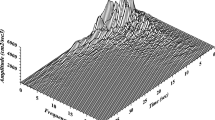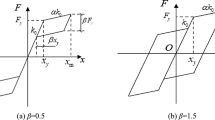Abstract
The ground acceleration is usually modeled as a filtered Gaussian process. The most common model is a Tajimi–Kanai (TK) filter that is a viscoelastic Kelvin–Voigt unit (a spring in parallel with a dashpot) carrying a mass excited by a white noise (acceleration at the bedrock). Based upon the observation that every real material exhibits a power law trend in the creep test, in this paper it is proposed the substitution of the purely viscous element in the Kelvin Voigt element with the so called springpot that is an element having an intermediate behavior between purely elastic (spring) and purely viscous (dashpot) behavior ruled by fractional operator. With this choice two main goals are reached: (i) The viscoelastic behavior of the ground may be simply characterized by performing the creep (or the relaxation) test on a specimen of the ground at the given site; (ii) The number of zero crossing of the absolute acceleration at the free field that for the classical TK model is \(\infty \) for a true white noise acceleration, remains finite for the proposed model.







Similar content being viewed by others
References
Ahmadi G, Fan FG (1990) Nonstationary Kanai–Tajimi models for El-Centro 1940 and Mexico city 1985 earthquake. Prob Eng Mech 5:171–181
Bagley RL (1989) Power law and fractional calculus model of viscoelasticity. AIAA J 27(10):1412–1417
Bagley RL, Torvik PJ (1983) Fractional calculus—a different approach to the analysis of viscoelastically damped structures. AIAA J 21(5):741–748
Bagley RL, Torvik PJ (1984) On the appearance of the fractional derivative in the behavior of real materials. J Appl Mech 51:294–298
Bagley RL, Torvik PJ (1986) On the fractional calculus model of viscoelastic behavior. J Rheol 30(1):133–155
Blair SGW, Caffyn JE (1949) An application of the theory of quasi-properties to the treatment of anomalous strain–stress relations. Philos Mag 40(300):80–94
Clough R, Penzien J (1995) Dynamics of structures. Computers & Structures, Berkeley
Di Paola M, Zingales M (2012) Exact machanical models of fractional hereditary materials. J Rheol 56:983–1004
Di Paola M, Pirrotta A, Valenza A (2011) Visco-elastic behavior through fractional calculus: an easier method for best fitting experimental results. Mech Mater 43:799–806
Di Paola M, Failla G, Pirrotta A (2012) Stationary and non-stationary stochastic response of linear fractional viscoelastic systems. Prob Eng Mech 28:85–90
Di Paola M, Pinnola F, Zingales M (2013) A discrete mechanical model of fractional hereditary materials. Meccanica 48(7):1573–1586
Ellingwood B, Batts M (1982) Characterization of earthquake forces for probability-based design of nuclear structures. US Nucl Regul Comm NUREG/CR-2945
Ellingwood B, Reeds D, Batts M (1983) Stochastic models of earthquakes for probability-based design of nuclear structures. Trans Int Conf Struct Mech React Tech K1/3:11–18
Flugge W (1967) Viscoelasticity. Blaisdell Publishing Company, Massachusetts
Grzesikiewiz W, Wakuliez A, Zbiciak A (2013) Non linear problems of fractional calculus in modeling of mechanical systems. Int J Mech Sci 70:90–98
Hindy A, Novak M (1979) Earthquake response of underground pipelines. Earthq Eng Struct Dyn 7:451–476
Kanai K (1957) Semi empirical formula for the seismic characteristics of the ground motion. Bull Earthq Res Inst Univ Tokyo 35:309–325
Li Y, Xia C (2000) Time-dependent tests on intact rocks in uniaxial compression. Int J Rock Mech Min Sci 37(6):467–475
Lin Y (1967) Probabilistic theory of structural dynamics. McGraw-Hill, NY
Liu SC, Jhaveni DP (1969) Spectral simulation and earthquake site properties. ASCE J Eng Mech Div 95:1145–1168
Nian T, Yu P, Diao M, Lu M, Liu C (2012) Shear-creep behavior of dredger fill silty sands under different normal pressure. Civ Eng Urban Plan 70:558–563
Nutting P (1921) A new general law of deformation. J Frankl Inst 19:679–685
Podlubny I (1999) Fractional differential equation. Academic Press, San Diego
Rezaeian S, Der Kiureghian A (2008) A stochastic ground motion model with separable temporal and spectral nonstationarities. Earthq Eng Struct Dyn 37:1565–1584
Rofooei F, Mobarake A, Ahmadi G (2001) Generation of artificial earthquake records with a nonstationary Kanai–Tajimi model. Eng Struct 23:827–837
Schiessel H, Blumen A (1993) Hierarchical analogues to fractional relaxation equations. J Phys A Math Gen 26:5057–5069
Schiessel H, Metzeler R, Blumen A, Nonnenmacher TF (1995) Generalized viscoelastic models: their fractional equations with solutions. J Phys A Math Gen 28:6567–6584
Schmidt A, Gaul L (2002) Finite element formulation of viscoelastic constitutive equations using fractional time derivatives. Nonlinear Dyn 29(1):37–55
Schmidt A, Gaul L (2006a) On a critique of a numerical scheme for the calculation of fractionally damped dynamical systems. Mech Res Commun 33(1):99–107
Schmidt A, Gaul L (2006b) On the numerical evaluation of fractional derivatives in multi-degree-of-freedom systems. Signal Process 86(10):2592–2601
Slonimsky GL (1961) On the law of deformation of highly elastic polymeric bodies. Dokl Akad Nauk SSSR 140(2):343–346
Spanos P, Evangelatos G (2010) Response of a nonlinear system with damping forces governed by fractional derivatives-onte carlo simulation and statistical linearization. Soil Dyn Earthq Eng 30(9):811–821
Tajimi H (1960) A statistical method of determining the maximum response of a building structure during an earthquake. Proc 2nd WCEE, Tokyo II:781–798
Ter-Matirosyan Z, Ter-Matirosyan A (2013) Rheological properties of soil subject to shear. Soil Mech Found Eng 49(6):219–226
Yang SQ, Cheng L (2011) Non-stationary and non-linear visco-elastic shear creep model for shale. Int J Rock Mech Min Sci 48:1011–1020
Yuan L, Agrawal OP (2002) A numerical scheme for dynamic system containing fractional derivatives. J Vib Acoust 124(2):321–324
Zbiciak A (2013) Mathematical description of rheological properties of asphalt aggregate mixes. Bull Pol Acad Tech Sci 61(1):65–72
Zerva A, Harada T (1997) Effect of surface layer stochasticity on seismic ground motion coherence and strain estimates. Soil Dyn Earthq Eng 16:445–457
Zerva A, Stephenson W (2011) Stochastic characteristics of seismic excitations at a non-uniform (rock and soil) site. Soil Dyn Earthq Eng 31(9):1261–1284
Author information
Authors and Affiliations
Corresponding author
Rights and permissions
About this article
Cite this article
Alotta, G., Di Paola, M. & Pirrotta, A. Fractional Tajimi–Kanai model for simulating earthquake ground motion. Bull Earthquake Eng 12, 2495–2506 (2014). https://doi.org/10.1007/s10518-014-9615-z
Received:
Accepted:
Published:
Issue Date:
DOI: https://doi.org/10.1007/s10518-014-9615-z




